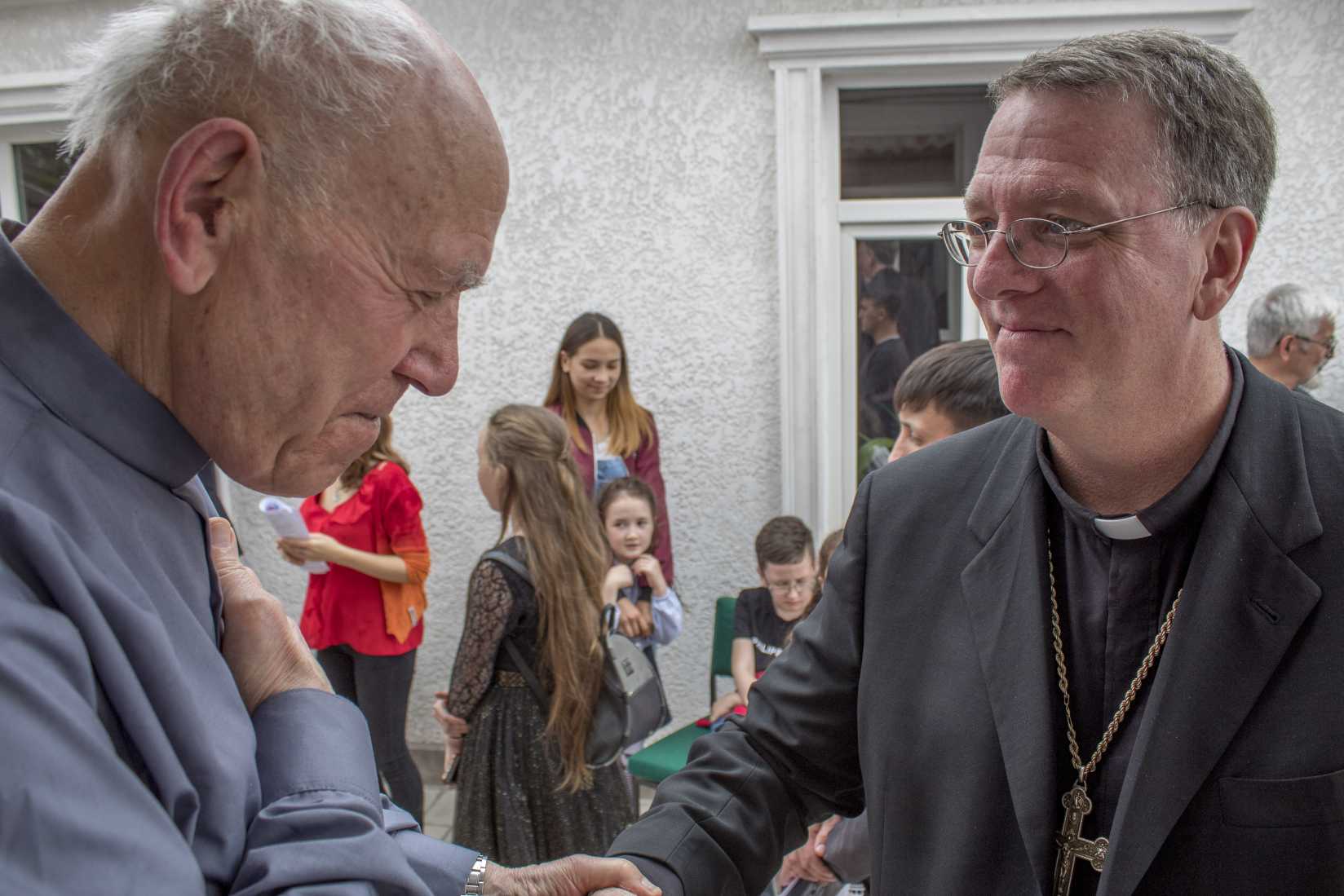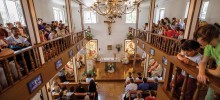
Father Anthony Corcoran with parishioner
Q&A with Fr. Anthony Corcoran, an American priest serving Catholics in Kyrgyzstan
Q&A with Fr. Anthony Corcoran, Apostolic Administrator of the Church in Kyrgyzstan (pictured on right)
Where do you serve in Kyrgyzstan? City? Countryside? Please describe it in ways that will help Americans to visualize the places you serve.
In fact, we serve throughout the entire country of Kyrgyzstan. Kyrgyzstan is a truly beautiful country, much of which is mountainous. It has been called “the Switzerland of Central Asia”—although, in all truth, it seems to many to be more rugged and more spectacular. I usually spend about a third to half of my time in the capital city of Bishkek (where our little cathedral parish and my office is located) and the rest of the time traveling, largely throughout the country to visit the little Catholic communities. Some of these are in towns. Other Catholics live in villages.
How long have you served in Kyrgyzstan?
I was appointed to serve in Kyrgyzstan in late summer of 2017. Before that I served in Russia—12 years in Siberia and 8 years in Moscow.
Help me understand your current ecclesiastical position. The paper says you are the apostolic administrator. Does that mean you are the acting bishop?
I am not a bishop; however, I am the ordinary, or head of the local Church.
Where are you originally from? How old are you?
I was born in southern Arizona and raised mostly in Texas. I am 57 years old.
Tell me a little about your own vocation story. How were you called to the Jesuits? How did your service in the former Soviet Union come about? Why were you assigned to Kyrgyzstan?
I got to know the Society of Jesus in college, at Marquette University. Although I always felt more attracted to either Franciscan spirituality or diocesan priesthood, I was drawn to the Spiritual Exercises of St. Ignatius and to the profound missionary spirit of the Jesuits.
As a novice, I read the remarkable story of Fr. Walter Ciszek’s ministry in the former Soviet Union. I became interested in the possibility of serving in Russia. At the dissolution of the Soviet Union, the Holy Father asked for Jesuits (among other orders) to go to the Soviet Union to find and serve the Catholics who had held onto their faith throughout the terrible persecution of the communists.
[For Jesuits] in the Russian Region, Kyrgyzstan was part of our mission. I was always fascinated with this country and people. After the unexpected death of my predecessor, Bishop Nikolai Messmer, I was asked to serve in Kyrgyzstan.
Tell me about the ministry team you work with. Where are the priests and sisters from? What are their areas of ministry?
We currently have seven Jesuit priests and one diocesan priest serving in various parts of Kyrgyzstan. These men are local Russian-Germans, Poles, a Slovenian, a Slovakian, and [I am the] token American. We have five sisters of the School Sisters of St. Francis who are all from Slovakia. There is also a Jesuit brother serving here. We are awaiting the arrival of sisters from the Consolata Missionary Sisters, who will serve in the southern part of our country.
Are the laity engaged in church leadership and ministry/outreach?
In fact, for decades before priests were allowed to minister (and even [before they were] freed from prisons and gulags), the laity led the community in prayer, catechized, and even sometimes baptized. There remains a strong sense of responsibility among many of the laity for the Church’s activity. What is most consoling is the presence of youth among some of those who lead the little communities in preparation for prayer.
What sorts of organized ministry—liturgical, social, and so on—do you offer? What is the response of the people?
There are nine “regular” parishes in the territory of the administration and more than ten smaller communities scattered throughout Kyrgyzstan where Mass is regularly celebrated, and [where] catechism and other faith formation [are] conducted. In addition, priests and sisters regularly travel to several other villages.
The Church, although small, undertakes several social projects (a house for single mothers, support for orphanages, etc.) and most notably the Children’s Rehabilitation and Spirituality Center on the shore of the enormous Issyk-Kul Lake. This Center undertakes remarkable activity: every year approximately 1,000 children (most of them with special needs, orphans, and children from poor families) participate in various programs, as do youth and adults. These participants are comprised of Catholics, Christians of other denominations, and Muslims. A key element of these activities for our own children includes different forms of formational and spiritual exercises. In Bishkek, we operate an educational center named Faith and Reason, offering talented youth supplementary educational programs in chemistry, mathematic, physics, biology, and informatics.
During the crisis caused by the coronavirus pandemic, the Church was involved in helping to provide basic food products to families as well as some medical supplies to several of the field hospitals that operated. We also hosted medical staff and youth volunteers who served during the crisis to rest and renew at our center.
Tell me about the church building where you serve—the one that will be featured in the poster for the national collection. [Church in Central and Eastern Europe Director] Tetiana [Stawnychy] tells me that there’s an interesting story about how it was built.
Although Catholics gathered in various places throughout the country during the late nineteenth and early twentieth centuries, the first Catholic parish in modern-era Kyrgyzstan was officially established in 1956. It was soon afterward destroyed by the communist regime of the Soviet Union; the pastor was returned to prison, and the most active faithful were dispersed into remote places far from the capital. In 1968, courageous parishioners initiated more assertive activity in Bishkek. Our little church in Bishkek (less than 100 square meters in size) was fashioned from another building the following year. Rather amazingly for that time, the Soviet government eventually allowed Catholics to register the church community. This process was permitted because this church was built far from the city center and other more densely populated places.
The balconies were secretly added by Catholics during a long weekend, since approval for such expansion would not have been permitted by the authorities. You can say that every inch, every nail of our church was built by the hands and hearts of our Catholics, who desired a place to gather and to pray and to receive the sacraments.
What are the Masses and liturgical services like? Very traditional? Contemporary? What do the people like to sing? Are there particular traditions that they bring to worship?
The Mass and liturgical prayer are generally rather traditional. The liturgical changes brought about in the Second Vatican Council were unknown until relatively recently. And of course, we don’t forget that there were decades without priests (the majority of whom either gave their lives for their faithful or were in prisons and gulags). In many places throughout the former Soviet Union, babushkas (or grandmothers) led prayers and songs that they recalled from childhood. Since the collapse of the Soviet regime, parish life has developed while maintaining some of the profoundly meaningful traditional prayers and practices. This having been said, most visitors note the striking effect of prayer in such small communities. . . . Others are sort of amazed at how almost all of the parishioners respond and sing during Mass.
How would you describe the prayer life of the people?
Again, many traditional prayers and practices remain vibrant in our little communities. Still, the prayers and desires of our Catholics are similar to those of Catholics throughout the world.
Are there particular saints (or blesseds/servants of God) who are particularly important to the Catholics of Kyrgyzstan?
In addition to devotion to many of the more well-known saints of the Church, Catholics here remember local heroes of the faith. Among these are the remarkable laywoman Gertrude Detzel (d. 1971), who taught, encouraged, and assisted countless Christians during and after her time in prison. As well, they love Fr. [Władysław] Bukowiński and [from the] Eastern Rite Aleksandr Her, who both served Catholics with outstanding faithfulness during extremely difficult times.
Your paper about the history of Catholicism in Kyrgyzstan was very moving. Do you still work with people who were sent there via deportation?
Most of these great witnesses to the faith are already gone. Many of our Catholics are the children and grandchildren of these remarkable Christians. Although it is difficult for us to conceive of such steadfast practice during such trying circumstances in which these people lived, we count on the ongoing intercession of these Catholics to [help us] remain faithful in our own generation.
What kinds of youth outreach are you able to offer? Do young people respond to the Catholic message of faith?
I should start by noting that our [local] Church—although very small—is relatively young. Visitors always remark on this fact . . . and on the quality of participation of many of these young people. In the cities, we have youth groups. Summer camps gather different age groups in various sessions—and this plays an important role in strengthening the identity of these young Catholics and forming them in the practice of their faith. Nevertheless, one of the greatest pastoral challenges is to continuously keep in contact with those young people—and others—who live so far from Catholic communities. We have to be honest in expressing our great concern for the spiritual, moral, and religious well-being of these young people. Influences working against their faith are many and powerful. Please pray for our youth.
What kinds of outreach to the elderly do you offer? What are the most pressing needs of the older generation?
The older generation is generally impoverished. Some have family who are able to care for them, and Kyrgyz culture is particularly loyal to elderly family members and even neighbors. Our parishioners are good in caring for each other. Still, many older people face hardships related to their lack of ability to pay for some of the basics of living. Each parish tries to assist to the extent that we are able.
In the sort of practical terms that can be addressed with financial gifts, what are the greatest needs and challenges that your ministry team faces? What could happen to improve ministry if people give generously to the US national collection?
There are really three main areas where the Church is in need [in Kyrgyzstan]. First is the many ongoing expenses related to operating mission life (basic expenses such as transportation between the missions, subsidizing the costs of heating, etc.). These often seem unspectacular but are the very basis (materially speaking) of our ability to function.
The second area is the assistance to people in need that we are called upon to provide.
The third is related to the need to build a modest, yet appropriate cathedral church in the capital. As important as our little church remains to our community, a church closer to the center of the city is necessary for better evangelizing (since it will be more visible and accessible). It will offer stability to the presence of the Catholic Church in complex social, political, and religious conditions. Likewise, it will serve to provide a cultural, academic, and humanitarian resource for the city. Our hope is to build an identifiably “Catholic” church, regarding architecture and interior. This will be the only one of its kind in the country and will stand for decades, if not centuries, as a testament to the presence of Catholics in this area.

